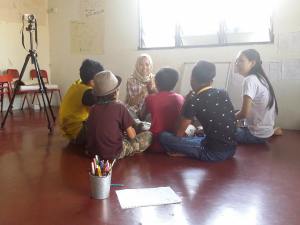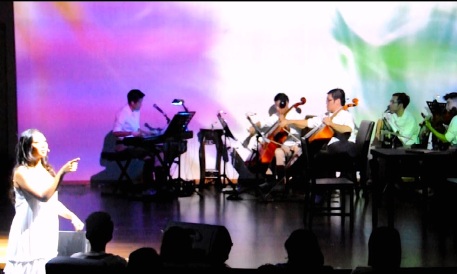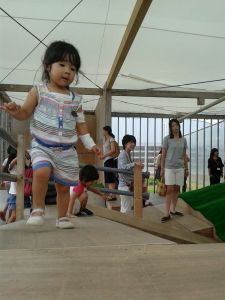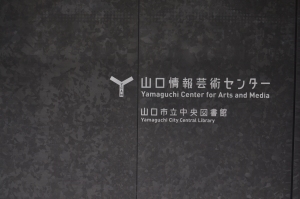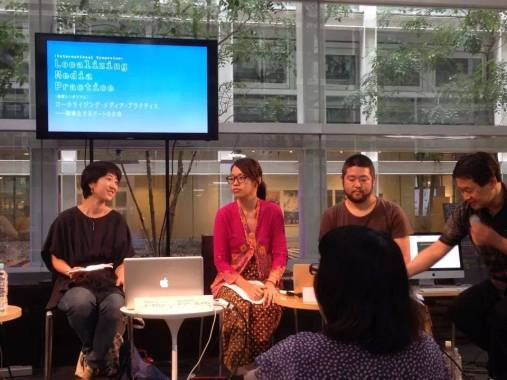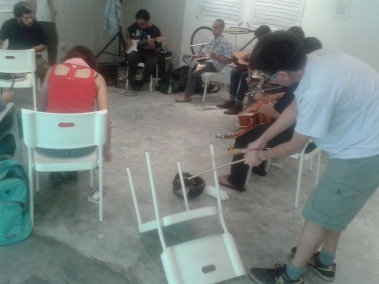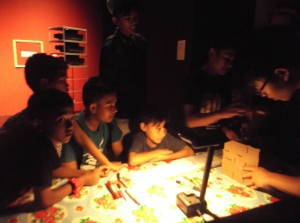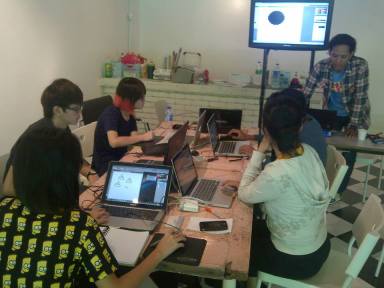Last month, I volunteered to take part in “Serasi”; workshops series for inner city kids. I would go as far as to mention it as a ‘disadvantaged community’. Hosted by Pusat Sekitar Seni (PSS) in Padang Jawa, it gave me a chance to be exposed to work with the urban poor youths. Initially, I offered to conduct an animation + architecture workshop. Perhaps to work on a simple stop-motion animation project using scale models or something.
But I quickly realized, my ideals are VERY different than the situation that presented itself in the next few days. I knew I had to come up with a PLAN B when I met my boys for the first time.
The ‘tough’ boys signed up for my workshop. These are the kind of boys that moms would warn their kids to stay away from at school (if they went at all). The high-school drop outs, the boys who’d skip class to smoke under bridges. Yup, they’d definitely make me work for my money this time. I spent half a day, observing them in the ice-breaking workshop.
But what struck me was their constant fascination with techno music. Maybe because it was highly danceable, and these boys would take any free time to connect his handphone to computer speaker and start dancing.
The other obstacle, was that I was the new ‘teacher’ (or cikgu, in Malay) at PSS this time, with the other facilitators as returning teachers.Sustaining the interest and attention of these boys, would be challenge, especially since I to make the learning interesting for them to come back for the next 4 days. I had to find a project that everyone found interesting enough to want to stick around for. The best way, I thought, was to start with something they liked and knew well; their techno music.
In one of my sessions, I exposed my group to script writing. My plan A, was to have a “storyboard session”. That didn’t work.
I noticed that the boys lacked the ability to visualize. Visualizing is one skill and the other skill was the ability to transfer what’s in the head onto a paper that can be shared and understood by others. That would require another 3 days with my boys. So I skipped that part.
One boy in the group named Johari, had a handphone with the music. I asked him to play the tune on repeat as they worked on their script. Once a loose script was done, we walked to the shooting locations, suggested by the boys (since it was their neighborhood) and prepared for “shoot day”,

I asked the boys to come up with a short story-line for their music video. They came up with the idea of a boy who was on his way to a concert and met his friends along the way.
The next day, I brought my laptop, my small camera and tripod. Shoot day went by like a breeze. I was so amazed at how well my small production crew of 3, took turns to shoot, direct and act. These boys showed a magical display of teamwork and dedication for their work that suprised me. It was almost like working with a professional team!
Once we got all the footage we needed, I picked Johari, who was also the eldest in thre group (16 years old), to edit the music video. He was very reluctant because he said he’s never touched a computer, but I shoved my macbook air to him anyway, “You can do it, Jo. I will show you how.” He turned the laptop on and the first thing I taught him was how to organize the footages into folders to make for efficient editing.
Not suprisingly, Johari aced it within hours. He handed me a rough cut before lunch.
Facilitators’ notes
This was, in no way what-so-ever, a workshop about improving one’s skills in technology/digital-based or media arts. I knew this boys were the type that learned from their environment. Howard Gardner talked about the “Multiple Intelligences theory” where he identified 8 intelligence combinations in people:
1. musical–rhythmic
2. visual-spatial
3. verbal-linguistic
4. logical–mathematical
5. bodily–kinesthetic
6. interpersonal
7. intra-personal
8. naturalistic
Looking back at my group, these boys are 1,2,5,6 and 8. They learn better when all their limbs are moving in space.
Digital technology was my excuse to bring these kids together. I knew by getting them to work outside, play with ‘fancy’ tools to produce something as pop culture as a music video, would help bring these boys to function as a team.
My bigger picture was to share the idea of collective learning/working. These boys worked amazingly as a collective. Something, most adults in modern society find difficult to do.
The other thing was, that learning can be a lot of fun, if its done right. Also, that no person is incompetent; everyone just needs to be motivated to work in a team, as a team. But, I have also noticed, how the kids jumped at anything digital media related. Perhaps it relates with the fact that it’s now very accesible, thanks to cheap knock-off smart phones and mobile devices.
All in all. I hope I can continue my work with such youths mainly because there is so much diversity in the narratives that they can bring to the creative table.
Here’s the final video rough cut vid made by the kids:



